A Beginner’s Guide to Piggery Business in the Philippines 2023
The Philippines is known for its thriving agricultural industry, and one of the most profitable businesses in this sector is piggery farming. With a high demand for pork in the local and international markets, pig farming can be a lucrative venture for aspiring entrepreneurs. However, like any business, it also entails risks and challenges that must be carefully considered before venturing into it. In this article, we will discuss the various aspects of piggery farming in the Philippines, including its pros and cons, profitability factors, business risks, requirements and regulations, and tips for success.
Whether you’re planning to start a small-scale backyard piggery or a large commercial operation, this guide will provide essential information to help you make informed decisions and succeed in this industry.
Table of Contents
What Makes Pig Farming Profitable?
Pig farming in the Philippines can be highly profitable due to a combination of factors. One advantage is its fast growth rate, meaning a quick return on investment (ROI). Furthermore, domestic consumption and export demand make pigs highly sought-after livestock in the country.
Pig farming offers many advantages, one being its ease of care. In addition, pigs are widely known to be cost-effective to feed as they can thrive on kitchen scraps, commercial feeds, or locally available ingredients; plus, their resistance to disease means lower veterinary expenses than other livestock.
Business Risks of a Piggery Business
As with any business venture, running a piggery in the Philippines carries its own set of risks. Here are some that you might face as a pig farmer:
- Market Risk: Demand for pork can fluctuate based on factors like seasonality, consumer tastes, and economic conditions; as a pig farmer, you face the risk of fluctuation in market prices that could eat into profits and negatively affect profits.
- Disease Outbreaks: Pigs can become vulnerable to infectious diseases that spread rapidly and kill entire herds quickly, resulting in significant financial losses for pig farmers.
- Feed Price Volatility: Feed costs can be an expense for pig farmers. Prices of ingredients used to create feed can fluctuate due to supply and demand issues, impacting profitability.
- Environmental Regulations: Pig farming can have a significant impact on the environment. As a pig farmer, you must abide by various environmental regulations, including waste disposal and management – any failure to abide by such rules can incur fines and penalties from regulatory bodies.
- Operational Risks: Pig farming poses numerous operational risks, including equipment breakdowns and power outages, which could impede operations and decrease profitability.
Pros and Cons Summary of a Piggery Business
Pros
- Fast Growth Rate = Fast ROI: One of the main advantages of pig farming is their rapid growth and maturation rate; therefore, farmers can anticipate seeing their return quickly with market weight achieved within months of starting farming operations.
- High demand: In the Philippines, pork is an indispensable food staple, and there is always an increased demand for it, creating a lucrative marketplace for pig farmers to sell their produce.
- Easy to raise: Pigs are relatively straightforward livestock to care for and require minimal space compared to cattle or goats. Furthermore, these adaptable creatures thrive under any environmental conditions, regardless of their surroundings.
- Cheap to Feed: Pigs are versatile omnivores and can be fed a range of food sources such as agricultural waste, kitchen scraps, and commercial pig feed. This makes them a cost-effective solution for farmers.
Cons
- Smelly and Noisy business: Pig farming can be an unpleasant business without effective waste management systems in place to handle manure disposal and noise generated by animals. Manure smell is strong and unpleasant, while animals may make noise that must be heard throughout a room or area.
- High Cost of Commercial Feeds: Although pigs can be fed from various food sources, commercially manufactured feed can be costly, adding production costs and decreasing profit margins for farmers.
- Vulnerability to Diseases: Although pigs tend to be healthy animals, they still become susceptible to certain diseases like swine fever and foot-and-mouth disease outbreaks that can have catastrophic results on farmers. Such outbreaks may result in significant losses.
- Inclement Weather: Typhoons or droughts can have a devastating impact on pig farming operations, affecting feed availability, water supply, and even animal health and wellbeing.
Problems Facing Pig Farming in the Philippines
Pig farming in the Philippines presents many unique obstacles which impede its profitability. Common issues faced by Filipino pig farmers include:
- Disease outbreaks: Pig farming is at risk from disease outbreaks that could pose significant financial losses for businesses in the Philippines, including African Swine Fever (ASF), Hog Cholera, and Foot-and-Mouth Disease. Farmers should implement biosecurity measures to safeguard against such outbreaks of infectious diseases.
- Fluctuating market prices: Pork prices in the market can fluctuate quickly, making it challenging for pig farmers to set competitive prices for their products. Supply and demand can have an immense impact on business profitability.
- High cost of inputs: Feed, labor, and other input costs may be high and harm your business’s production costs and profits. This may have detrimental repercussions on its profitability.
- Environmental regulations: Pig farming can produce large volumes of waste that harm the environment. Farmers must comply with environmental regulations and implement sustainable waste management practices to minimize this effect.
- Lack of access to financing: Accessing financing may present small-scale pig farmers with difficulty, as they may need more collateral to secure loans, invest in their businesses, and expand operations. This could hinder investment decisions as well as expansion plans.
- Lack of technical knowledge and training: Pig farming requires technical know-how and training to implement best practices and optimize production. With such knowledge, farmers may be able to manage their businesses effectively, leading to decreased productivity and profits.
The Importance of a Piggery Business Plan
A piggery business plan is a written document that details the objectives, strategies, and actions required to establish and run a successful pig farming enterprise. It serves as an essential resource to help determine whether their idea can be realized while simultaneously identifying challenges that may arise and developing solutions to overcome them.
An effective business plan is critical to any piggery business’s success. A properly written plan enables an entrepreneur to outline their purpose, goals, target market, and competitive analysis. A quality business plan also includes financial projections that project the income and expenses of their operation to help determine how much capital is necessary to start and operate it successfully.
An effective piggery business plan can also assist with obtaining funding from banks and investors, who often require detailed plans before agreeing to fund any venture. A comprehensive business plan increases your chances of receiving the adequate funds necessary to start and run the venture successfully.
Business plans provide entrepreneurs with a roadmap to reach their business objectives. A good business plan lets you stay focused and organized, taking all the steps needed to reach desired outcomes. Furthermore, they serve as an instrument to measure performance against stated objectives, helping the entrepreneur make informed decisions and changes where necessary.
Overall, a piggery business plan is an indispensable resource for entrepreneurs seeking to launch and run a profitable pig farming operation in the Philippines. It provides a roadmap toward meeting desired outcomes by outlining a framework and helping secure financing.
Types of Piggery Business
Before beginning a piggery business in the Philippines, it’s essential to determine its type. Two main categories of piggeries include breed and grow and grow-out operations.
Breed and Grow vs. Grow-Out
Breed and grow refers to a piggery business that involves breeding and raising piglets until they reach maturity, typically over an extended timeframe and higher initial investment, but offers higher returns in return.
Grow-out piggery businesses involve purchasing young piglets and raising them until market weight. While this requires less investment and time commitment, its returns are typically smaller.
Independent Grower vs. Contract Grower
As well as considering which type of grower operation best suits them, another factor to consider is whether they want to operate as an independent or contract grower. Independent growers own and manage their pig production, while contract growers provide service for companies or corporations.
Ultimately, deciding upon a piggery business type depends on your resources, goals, and preferences as an entrepreneur.
Determining Your Business Setup
Acquiring Starter Pigs or Adopting a Grow-Out System
When starting a piggery business in the Philippines, determining the proper business setup is crucial for success. One important decision is whether to acquire starter pigs or adopt a grow-out system.
Acquiring starter pigs involves purchasing young pigs from breeders or other sources and raising them until they reach the desired weight or age for selling. This approach requires more resources and attention to ensure the healthy growth of the pigs.
On the other hand, adopting a grow-out system involves taking in young pigs for a fee and raising them to the desired weight or age as contracted by a third-party entity. This approach requires less capital and management skills as the third-party entity provides the piglets and oversees their growth, but it also means a lower profit margin.
When deciding on the business setup, it’s essential to consider factors such as the available resources, level of experience, and market demand.
Business Requirements for a Piggery Business in the Philippines
Several requirements must be fulfilled to operate a piggery business in the Philippines legally. Below are the six primary requirements:
1. Register Your Piggery Business
Before opening any business in the Philippines, its details must be registered with either the Department of Trade and Industry (DTI) or the Securities and Exchange Commission (SEC), depending on its nature. Doing this ensures your piggery is legally recognized within its operating boundaries.
2. Obtain Barangay Clearance
To conduct business within the local barangay’s jurisdiction, obtaining a barangay clearance certification from its hall is necessary.
3. Acquire a Mayor’s Business Permit and Sanitary Permit
These permits can be obtained from Municipal or City Hall and validate that your business can operate legally within its area, while the Sanitary Permit ensures public health safety is maintained at your piggery.
4. Register with the Bureau of Internal Revenue (BIR)
All businesses operating in the Philippines are required to register with the Bureau of Internal Revenue and obtain a Tax Identification Number (TIN) to ensure they pay all applicable taxes according to regulations and comply with tax compliance obligations. This ensures your piggery business meets tax regulations correctly.
5. Register with the SSS, PhilHealth, and Pag-Ibig Fund
These government agencies offer benefits such as social security, health insurance, and loan programs for employees of your piggery business. You must register with these agencies to hire employees.
6. Secure an Environmental Certificate
Obtain an Environmental Certificate: This certification from the Department of Environment and Natural Resources (DENR) ensures that your piggery does not harm the environment, which is particularly important given that piggery businesses often generate large volumes of waste and pollutants that must be managed appropriately to function efficiently.
Location Requirements of a Piggery Business
- Choose a location away from residential areas and water sources to avoid contamination and odor issues
- The location must be accessible for the transport of pigs and supplies
- The site must have good drainage and be flood-free
- The soil must be suitable for construction and able to support the weight of the pig houses and equipment
- Adequate space must be available for the construction of pig houses, feed storage, and other necessary facilities
- The site must have a reliable source of water and electricity
- The location must be compliant with zoning and environmental regulations
Pig Housing Requirements in the Philippines
Philippine pig houses must meet certain specifications to ensure the comfort and health of its residents, with some essential requirements including:
- Ventilation: To keep ammonia levels under control and to regulate temperature and humidity levels inside the pig house, proper ventilation must be installed in its interior space. Achieving good ventilation also provides for more uniform temperature distribution in its environs.
- Flooring: To prevent slipperiness and moisture build-up, flooring must be nonslip and easy to keep clean. Furthermore, good drainage should be available to reduce waste accumulation.
- Lighting: Lighting is vitally important for maintaining the health and productivity of pigs. An optimal environment requires both natural and artificial illumination that regulates biorhythms while stimulating growth.
- Watering System: To provide its pigs with fresh, clean water at all times, the pig house must contain an efficient watering system that is easy to use and clean up after. Furthermore, maintenance should be minimal with this type of setup.
- Feeding System: To ensure optimal conditions in their pig house, owners should install an efficient feeding system that allows for the easy distribution of feed to their animals while remaining easy to clean and maintain.
- Space: To provide comfort for the pigs in a home environment, there must be sufficient room. This depends on their size and age.
- Biosecurity: To avoid disease transmission in pig houses, proper biosecurity measures must be implemented, such as quarantine areas, footbaths, and disinfection protocols.
As specific requirements can vary depending on the location and size of your pig house, it is wise to consult a veterinarian or expert in pig farming to ensure that the house meets all necessary standards.
Choosing the Right Piglets
Common Pig Breeds in the Philippines
There are several pig breeds that are commonly raised in the Philippines for meat production. Here are a few popular breeds:
Yorkshire or Large White
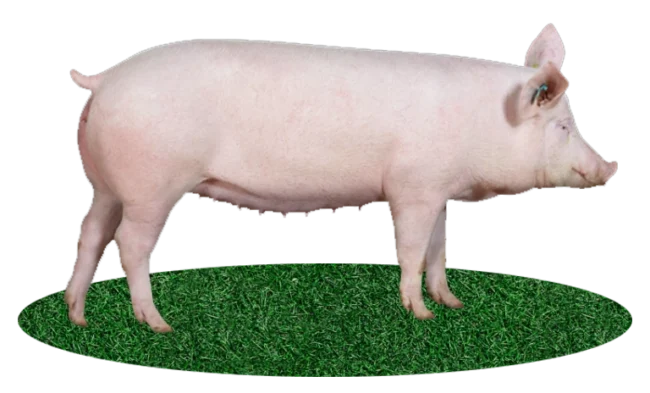
This breed is well known for its high lean meat content, fast growth rate, adaptability to various environmental conditions, and immunity to common pig diseases.
Landrace

These breeds are known for their large, drooping ears and high meat yield, along with excellent mothering abilities that make them popular choices when breeding sows.
Duroc
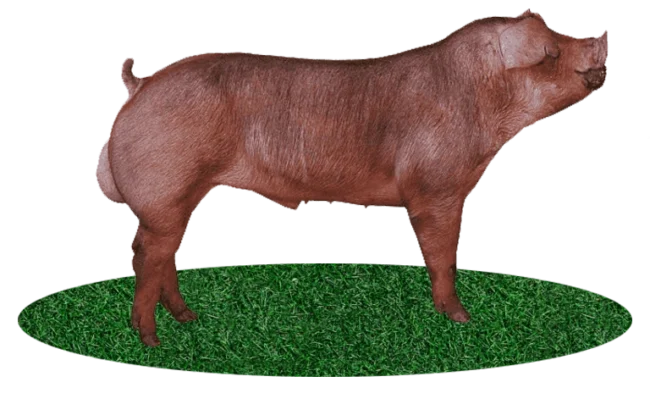
Duroc breed is well known for its flavorful meat, high growth rate, and efficient feed conversion efficiency, making them an economical option for commercial farming operations.
Hampshire
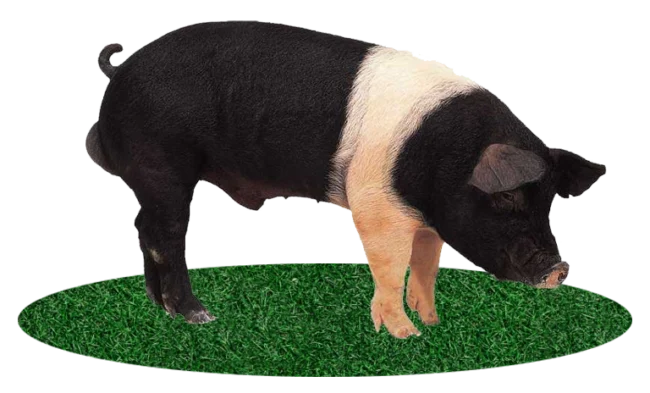
This breed is well known for its muscular bodies and excellent meat quality, along with being resistant to stress – making them an excellent choice for intensive farming systems.
Berkshire
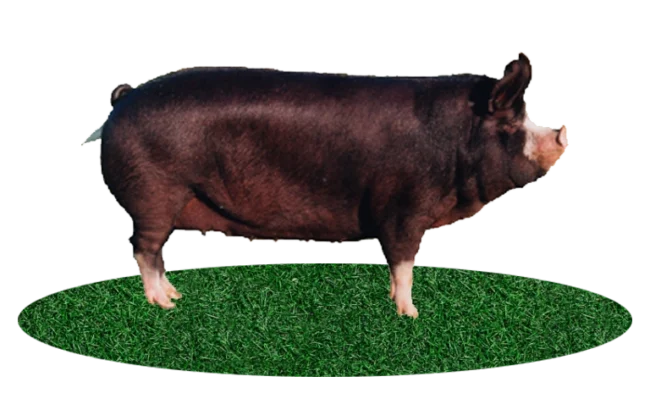
This breed is prized in the culinary industry due to its marbled meat. Furthermore, they boast good mothering abilities and adapt well to various feeding systems.
Pietrain
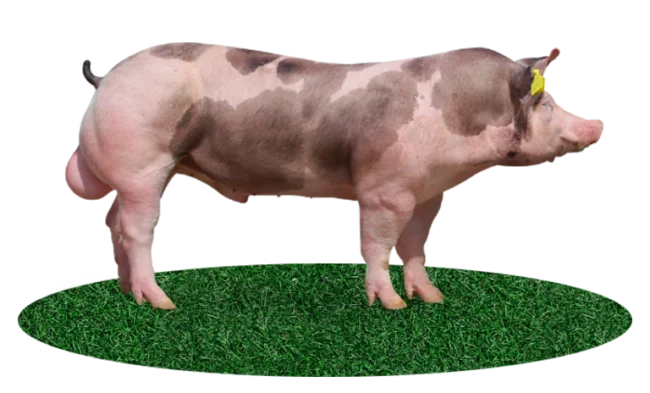
This breed is well known for its high lean meat content and rapid growth rate, and its resistance to stress makes them ideal for intensive farming systems.
Other Breeds to consider:
Philippine Native Pig (PNP)
Also referred to as an “asal” or a “native baboy”, these traditional breeds have been raised throughout the Philippines for centuries. They are known for their hardiness, adaptability to local conditions, and flavorful meat.
Tamworth
This breed is recognized for its long snout and ginger-colored fur. They excel at foraging for food outdoors, making them an excellent option for free-range farming systems.
Meishan
Meishan breed is distinguished by their wrinkled faces and large, floppy ears, as well as their high reproductive performance and large litter sizes, making them an excellent choice for sow breeding programs.
Hampshire-Duroc crossbreeds
This hybrid breed is widely popular in the Philippines, as it combines the meat quality of Hampshires with the growth rate of Durocs for optimal commercial pig farming resulting in high meat quality and growth rates in each piglet. This results in high meat yield and rapid development rates that make this hybrid ideal.
Pietrain-Duroc crossbreed
This crossbreed combines the fast growth rate and lean meat content of Pietrain with the high feed efficiency and reliable growth rate of Duroc for maximum lean meat content and rapid growth rate, making this cross an excellent choice for intensive farming systems.
Selecting an ideal pig breed for your piggery business depends on several considerations, such as its target market, farming system, and production goals. Do your research and consult experts to decide which breed will work best in terms of production efficiency and market trends.
Important Piggery Farming Tips
Start Small
Starting with a manageable number of pigs is essential, especially if you are new to the industry. This will allow you to gain experience and knowledge on properly caring for and managing the pigs before expanding your business. Starting small also means minimizing your initial investment and reducing your risk of financial loss.
Obtain Financial Aid
Starting a piggery business can be expensive, so exploring financial aid options such as loans or grants is essential. This can help cover the cost of acquiring starter pigs, constructing pig houses, and purchasing equipment and feeds. Be sure to research and compare different options to find the best fit for your business needs.
Get Technical Help
It is always a good idea to seek technical assistance and advice from experts in the field, especially if you are new to the industry. This can help you avoid common mistakes and learn best practices for pig farming. You can seek assistance from government agencies, universities, or private organizations specializing in pig farming. Attend seminars, workshops, or conferences to gain new knowledge and skills to improve your operations.
Easy Step Guide to Piggery Farming
Establishing a piggery farming business can be both rewarding and profitable; however, it also requires hard work. A solid plan must be put in place, along with being aware of any challenges that might arise along the way. By following these eight easy steps and staying current with industry developments and best practices, you’ll soon be well on your way to running a profitable piggery farming enterprise! Good luck on your journey!
Step 1: Receive Training to Raise Pigs
Before starting your own piggery farm, it is crucial to equip yourself with knowledge and skills on caring for pigs properly. This knowledge can be gained by attending seminars, workshops, or training programs.
Step 2: Select an Appropriate Land
When it comes to piggery farms, choosing an ideal location is paramount. In addition, your piggery farm needs adequate drainage and ventilation systems, proximity to residential areas that do not interfere, clean water supplies available nearby, and access to electricity if applicable.
Step 3: Obtain Productive Pig Breeds
You must select productive pig breeds that can thrive in your location and meet market demands, considering factors like growth rate, feed conversion efficiency, and disease resistance when making this selection.
Step 4: Start the Pig Housing Process
Establishing proper housing for your pigs is vital to their health and comfort, so ensure it is clean, well-ventilated, and offers enough room for movement.
Step 5: Feed the Pigs Efficiently
Providing your pigs with appropriate feed and nutrition is vital to their growth and well-being, so consult animal nutrition specialists to create a balanced diet.
Step 6: Initiate the Breeding Process
Beginning breeding procedures is crucial in keeping an adequate supply of piglets for sale or raising. Ensure your breeding stock is healthy, and develop an action plan.
Step 7: Ensure Proper Care and Management
Providing your pigs with proper care and management practices is paramount to their health and productivity, including regular health check-ups, waste disposal strategies, and disease prevention measures.
Step 8: Focus on Marketing Your Products
To successfully promote and market your products, you must identify target buyers and develop marketing strategies accordingly. For example, consider joining farmers’ markets or creating direct relationships with restaurants and meat shops to promote your pig products.
Feeding Management of Pigs
Feed management is a critical element of pig farming to ensure their health and productivity. As omnivores, their diet must provide them with enough essential nutrients for healthy development and growth. Here are a few critical considerations for effective feeding management in pig farming:
- Feed Composition: Pig feed should contain a balanced combination of proteins, carbohydrates, fats, vitamins, and minerals for proper growth, reproduction, and disease prevention.
- Feeding Schedule: Pigs should be fed twice daily to ensure sufficient nourishment. Their feeding schedule should remain regular to avoid digestive issues and promote optimal weight gain.
- Feed Quantity: Feed amounts should vary based on each pig’s weight, age, and stage of development. Overfeeding may lead to obesity, while underfeeding can hinder their growth and productivity.
- Feed Quality: For optimal pig health, feed should be free from contaminants such as mold and pesticides to avoid potential health problems in their digestive systems.
- Water: Pigs need access to fresh, clean water at all times for digestion, hydration, and maintaining body temperature regulation. Adequate intake ensures effective digestion, hydration, and regulation.
- Feeder and Waterer Design: When designing feeders and waterers for pigs, their design must consider their size and age, as well as provide durable equipment that’s easy to use and clean – and prevent unnecessary waste.
- Feed Storage: For optimal results, feed should be kept in a dry, calm, and ventilated location to reduce spoilage and contamination.
- Feed Costs: Feed costs can be an expensive component of pig farming, and farmers should aim to minimize waste and optimize the conversion ratio to decrease overall costs.
Feed management is critical to the success of pig farming operations. Routine monitoring of feed intake, body condition scores, and growth performance can help identify health or nutrition issues early on.
Health Management for Pig Farming
Health management is an essential aspect of pig farming to ensure the health and productivity of the pigs. Here are some critical practices for effective health management in pig farming:
- Vaccination: Vaccination is essential for preventing and controlling diseases in pigs. It is important to follow a vaccination schedule recommended by a veterinarian to ensure that pigs are adequately protected against common diseases.
- Biosecurity measures: Biosecurity measures are put in place to prevent the introduction and spread of diseases on the pig farm. These measures may include quarantining new animals, limiting visitors, providing proper sanitation, and using protective gear.
- Parasite control: Parasites can have a significant impact on the health and productivity of pigs. Proper deworming and treatment for external parasites should be implemented regularly to ensure optimal health.
- Proper nutrition: Providing proper nutrition is essential to maintain the health and productivity of pigs. A balanced diet that meets the nutritional requirements of pigs at each stage of growth should be provided.
- Observation and monitoring: Regular observation and monitoring of the pigs can help to identify any health problems early. Early detection can lead to prompt treatment, minimizing the impact of disease on the pig herd.
- Record keeping: Accurate records of pig health, medication, vaccination history, and production data are essential for effective health management. This information can help identify trends and potential problems and inform decision-making for the management of the pig herd.
By implementing these health management practices, pig farmers can help ensure the health and productivity of their pigs while minimizing the risk of disease outbreaks on the farm.
Final Thoughts
Pig farming in the Philippines can be a rewarding and successful venture but requires meticulous planning, research, and management to succeed. As with any business endeavor, challenges will always be associated with it; however, with the appropriate knowledge and preparation, these can be overcome successfully.
Starting a piggery business involves numerous considerations, from obtaining permits and registrations to choosing suitable land and breeds for breeding pigs to building housing with appropriate feeding management systems to ensure their health and welfare, among others.
First, educating yourself about the industry is vital, as seeking advice from experienced pig farmers and keeping up-to-date with the latest farming techniques and trends. You can build a prosperous and lasting business venture by adhering to this guide’s steps and following best practices for pig farming.
Piggery in the Philippines can provide an income source and contribute to its flourishing agricultural sector with hard work, dedication, and high-quality pork products.
Frequently Asked Questions
Is pig farming profitable in the Philippines?
Yes, pig farming can be a profitable business in the Philippines due to the high demand for pork meat in the market.
How can I raise my pig faster?
You can raise your pig faster by providing them with proper nutrition, suitable housing, and hygiene management, as well as by maintaining a regular vaccination and deworming schedule.
What common diseases affect pigs, and how can they be prevented?
Common diseases that affect pigs include swine fever, foot-and-mouth disease, and porcine reproductive and respiratory syndrome (PRRS). These diseases can be prevented through proper vaccination, quarantine, and hygiene management practices.
How do I market my pig products?
You can market your pig products through various channels such as social media, direct selling, and through local markets and meat shops.
What are the financing options available for starting a piggery business?
There are various financing options available for starting a piggery business in the Philippines, including bank loans, government-sponsored programs, and private investors.
How much land is required for a piggery business?
The amount of land required for a piggery business depends on the size of the operation. For a small-scale piggery, around 100 to 1000 square meters of land may be sufficient.
What are the legal requirements for transporting pigs?
Legal requirements for transporting pigs include obtaining the necessary permits and licenses, ensuring proper documentation and identification, and complying with biosecurity measures.
What are the best practices for animal welfare in piggery farming?
Best practices for animal welfare in piggery farming include providing adequate space and housing, proper nutrition and feeding management, regular veterinary care, and humane handling and transportation.
How do I manage waste and manure from my piggery?
You can manage waste and manure from your piggery by using proper disposal methods, such as composting, and ensuring that manure does not contaminate nearby water sources.
What is the typical lifespan of pigs in a piggery business?
The typical lifespan of pigs in a piggery business can vary depending on the purpose of the operation. Breeding sows can live up to 5-6 years, while pigs raised for meat can be slaughtered as early as 4-6 months of age.
Can I combine pig farming with other agricultural activities, such as crop farming or poultry farming?
Yes, pig farming can be combined with other agricultural activities, such as crop farming or poultry farming, to maximize land use and profitability.
How can I improve the genetics of my pig herd?
You can improve the genetics of your pig herd by selectively breeding high-performing pigs and culling those with poor traits, as well as by introducing new genetics through purchasing new breeding stock.
